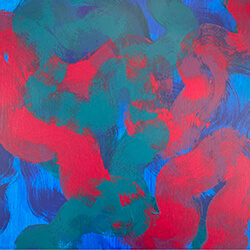Hoffman Gallery
May Gallery Exhibition
Exhibit-Thursdays–Sundays | May 1–31 | 12:00-5:00pm
Opening Reception May 3 | 3:00-5:00pm
Gallery is closed the last Sunday of every month
Hoffman Center for the Arts | 594 Laneda Avenue | Manzanita
Free and open to the public
Featuring Works by
Jenny Rideout, Victoria Christen, Robert Sumner
Jenny Rideout – Sails, Freq Flags, and Bonnets for Space Exploration

In my ongoing series Sails, Freq Flags, and Bonnets for Space Exploration, I work with found textiles—quilts beyond repair, drop cloths, vintage scraps—alongside acrylic paint and India ink to create mixed-media assemblages that meditate on power, protection, and transformation.
This body of work began with a vision I had of a majestic old tall ship. I saw intricate patchwork sails maneuvering the ship elegantly and powerfully along the constantly shifting surface of the ocean. In my vision, the sails were covered in colorful mends, mysterious symbols, sigils, and patterns. The resulting sails are meditations on power, creativity, and the culmination of experiences alchemized for maximum propulsion. These works are both talismans and tools: sails to catch the wind of imagination, flags to signal inner frequencies, and bonnets to shield and amplify the self on its voyage through inner space.
“Freq Flags” (or frequency flags) are inspired by burgees—small flags flown on seafaring vessels to indicate home port. Also drawing from ancient sacred art, they are meant to be deeply grounding yet brightly expansive at the same time. They are about holding one’s home frequency even in the midst of wild exploration.
Envisioned as headwear for the crew on my “ship,” Bonnets for Space Exploration point to inner archetypes that are at once ancient and futuristic.
I draw on domestic traditions of sewing and mending passed down through generations in my family—quilting, patching, sail repair—and channel them into a kind of speculative folk art. The materials carry time and wear, bearing histories I can only partially access. Through stitching, painting, and layering, I offer them new roles—as sacred garments, ritual objects, or navigational gear for a future that values repair, complexity, and play.
This work imagines survival not just as endurance, but as joyfully outfitting ourselves for the unknown with the scraps we’ve inherited and reimagined.
Victoria Christen – ShapeScapes

I began working with found shapes almost thirty years ago, first collecting discarded felt pieces from a factory dumpster across the street from my studio in Portland, Oregon.
I stored them for two decades before deciding to use them to create an alphabet of over twenty combinations of fabric shapes sewn or glued together. These have become my foundation for expression, a lens that I use to view and interpret the world around me.
Some of the pieces in the exhibition are combinations of shapes used to represent the beauty and majesty of the Wallowas, where I did a summer residency. Others are shape-based interpretations of rock formations seen from ocean shores.
Robert Sumner – Visual Music

My work uses the synesthetic, non-verbal communicative power that the visual arts share with the performing arts, especially music, as a jumping off point to explore color, form and movement.
Music and dance have clear analogs in the visual arts: rhythm, repetition, improvisation, melody and harmony, and even syncopation. The visual arts add color, texture, transparency, opacity, and the physical capture of the passing of time.
The combination and interaction of these formal elements communicate at a pre- and non-discursive level that is simultaneously more fundamental and more expansive than verbal communication. The writings of Henri Bergson and others explore the limitations verbal communication places on our understanding of the human experience, and it is precisely the communication and experience that lies beyond these limitations that I strive to explore.
**A Note on Titles: In order to create titles that were conceptually consistent with my objective of creating imagery that is an open yet suggestive abstract matrix, I developed a rubric to pull random syllables from James Joyce’s Finnegans Wake, which is a remarkable piece of literature in which words create an open yet suggestive matrix.
About Robert Sumner
Robert Sumner is largely self-taught after being disenrolled from the 4th year of his BFA program due to his sexual orientation. Returning to school a few years later he developed, proposed, and completed an interdisciplinary degree in Arts Administration at Old Dominion University in Norfolk, Virginia after which he completed the MBA program at the University of California at Davis. He has been creating art his entire life but has been doing it full time since early 2024 while residing in Portland, OR. His practice consists of painting and printmaking.
Additional work can be seen on his website
Click here to view and download event flyer





